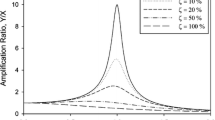Abstract
After an earthquake, the condition of industrial systems, structures and equipment, especially at nuclear power plants has to be assessed since this information is needed for accident management and for the decision on the continuation of the operation. The damaging potential of the earthquake can be characterized by maximum horizontal acceleration of the ground motion, response spectra, cumulative absolute velocity and different instrumental intensity values. These quantities can be correlated with the earthquake characteristics, magnitude, distance, etc. Some of the indices are selective to damage mechanism and can be correlated to load-bearing features of the structures. Different indicators of damaging potential of earthquakes are analyzed in the paper from the point of view of applicability for post-event condition assessment at nuclear power plants and for using as criteria for restart of the operation.


Similar content being viewed by others

References
ASME (2010) ASME boiler and pressure vessel code (BPVC), Section III: Rules for construction of nuclear power plant components, Division 1, Subsection NB: Class 1 components. American Society of Mechanical Engineers, 01-Jul-2010. ISBN: 9780791832370
ASME/ANS RA-S-2008 (2008) Standard for level 1/large early release frequency probabilistic risk assessment for nuclear power plant applications
Budnitz RJ et al (1985) An approach to the quantification of seismic margins in nuclear power plants. Lawrence Livermore National Laboratory, NUREG/CR-4334
Cabanas L, Benito B, Herraiz M (1997) An approach to the measurement of the potential structural damage of earthquake ground motions. Earthq Eng Struct Dyn 26:79Đ92
EPRI (1988a) A methodology for assessment of nuclear power plant seismic margin. Electric Power Research Institute, NP-6041
EPRI (1988b) Criterion for determining accidence of the operating basis earthquake. EPRI NP-5930, July
EPRI (1991) Standardization of the cumulative absolute velocity. Report No EPRI TR-100082-T2, EPRI, Palo Alto, California
Goldberg BE et al (1994) System engineering “Toolbox” for design-oriented engineers. NASA reference publication 1358, December
Hancock J, Bommer JJ (2004) Predicting the number of cycles of ground motion. In: 13th world conference on earthquake engineering, Vancouver, B.C., Canada, 1–6 August 2004, Paper No 1989
Hancock J, Bommer JJ (2005) Predicting the number of cycles of ground motion. Earthq Eng Struct Dyn 2005(34):637–664
Heacock DA (2011) North Anna power station restart readiness. Public meeting 1st November 2011. http://www.nrc.gov/info-finder/reactor/na/dominion-slides-11-01-2011-meeting.pdf
IAEA (2011) Earthquake preparedness and response for nuclear power plants. IAEA safety reports series, vol 66. IAEA, Vienna. ISBN 978-92-0-108810-9
Katona TJ (2010) Options for the treatment of uncertainty in seismic probabilistic safety assessment of nuclear power plants. Pollack Period 5:(1):121–136
Katona TJ (2011) Interpretation of the physical meaning of the cumulative absolute velocity. Pollack Period 6(1):9–106
Katona TJ (2012, to be published) Modeling of fatigue type seismic damage for nuclear power plants. Comput Mater Sci 64:22–24
Kostov M (2005) Site specific estimation of cumulative absolute velocity. In: 18th international conference on structural mechanics in reactor technology (SMiRT 18), Beijing, China, 7–12 August 2005, paper SMiRT18-K03-4
Kramer S, Mitchell RA (2006) Ground motion intensity measures for liquefaction hazard evaluation. Earthq Spectra 22(2):413–438
Kramer S, Upsally SB (2006) Instrumental intensity scales for geohazards. In: ECI conference on geohazards. http://services.bepress.com/eci/geohazards/11
KTA 2201.4 (1990) Auslegung von Kernkraftwerken gegen seismische Einwirkungen. Teil 4. Anforderungen an Verfahren zum Nachweis der Erdbebensicherheit für maschinen- und elektrotechnische Anlagenteile, Fassung 6/90
KTA 2201.6 (1992) Auslegung von Kernkraftwerken gegen seismische Einwirkungen. Teil 6. Maßnahmen nach Erdbeben, Fassung Juni 1992
KTA 3201.2 (1996) Komponenten des Primärkreises von Leichtwasserreaktoren. Teil 2. Auslegung, Konstruktion und Berechnung, Fassung 6/96
Minagawa K, Fujita S, Kitamura S, Okamura S (2007) Fracture prediction of piping using energy balance method. In: Transactions of SMiRT 19, Toronto, August 2007, paper # K12/5
Nie J, Xu J, Costantino C (2006) P-CARES: probabilistic computer analysis for rapid evaluation of structures. NUREG/CR-6922, BNL-NUREG-77338-2006
Nukleáris Biztonsági Szabályzatok (2012) 3. kötet, Atomerőművek tervezési követelményei, 37/2012. (III. 9.) Korm. rendelet, Magyar Közlöny. évi 28. szám 2. melléklet a 37/2012. (III. 9.) Korm. rendelethez
Ochiai K, Kobayashi K, Chigama A (2010) Damage indicating parameters and damage modes of mechanical components. In: 1st Kashiwazaki international symposium on seismic safety of nuclear installations and embedded topical meetings, November
Panza GF, Cazzaro R, Vaccari F (1997) Correlation between macroseismic intensities and seismic ground motion parameters. Ann Geofis XL(5):1371–1382
PNAE G-7-002-86 (1989) Нормы расчета на прочност оборудования и трубопроводов атомных энергетических установок, ПНАЭ Г-7-002-86. Энергоатомиздат, Москва
Prassinos PG, Ravindra MK, Savay JD (1986) Recommendations to the nuclear regulatory commission on trial guidelines for seismic margin reviews of nuclear power plants. Lawrence Livermore National Laboratory, NUREG/CR-4482
Qu Z, Ye L (2010) Strength deterioration model based on effective hysteretic energy dissipation for RC-members under cyclic loading. In: Joint conference proceedings, 7th international conference on urban earthquake engineering (7CUEE) & 5th international conference on earthquake engineering (5ICEE), Tokyo, Japan, 3–5 March 2010, Tokyo Institute of Technology
Virginia Electric and Power Company (Dominion) (2011) North Anna power station units 1 and 2, North Anna independent spent fuel storage installation—summary report of August 23. 2011 earthquake response and restart readiness determination plan. Virginia Electric and Power Company, Richmond, Virginia 23261, September 17, 2011. https://www.dom.com/about/stations/nuclear/north-anna/pdf/Earthquake_Summary_Report_and_Restart_Plan_091711.pdf
Ye L, Ma Q, Miao Z, Guan H, Zhuge Y (2011) Numerical and comparative study of earthquake intensity indices in seismic analysis: the structural design of tall and special buildings. (doi:10.1002/tal.693). Article first published online: 28 Feb 2011. http://onlinelibrary.wiley.com/doi/10.1002/tal.693/pdf
Author information
Authors and Affiliations
Corresponding author
Rights and permissions
About this article
Cite this article
Katona, T.J., Tóth, L. Damages indicators for post-earthquake condition assessment. Acta Geod Geophys 48, 333–345 (2013). https://doi.org/10.1007/s40328-013-0021-9
Received:
Accepted:
Published:
Issue Date:
DOI: https://doi.org/10.1007/s40328-013-0021-9



